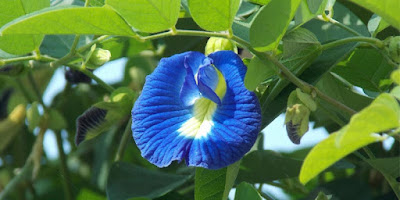10 Health Benefits of Blue Butterfly Pea
Vividly deep blue, with a solitary hint and marked with light yellow color, the blue butterfly flower is a treat to the eyes. Also known as Asian pigeonwings, butterfly pea, Kordofan pea and Darwin pea, and botanically names as Clitoriaternatea. It is native to equatorial Asia. Often grown as an ornamental plant, the blue butterfly plant requires little care when cultivated. The bright blow color of the butterfly pea has been used as a coloring agent in food. It comes with a host of health benefits. It has also been used in traditional Ayurvedic medicine to treat various ailments. The traditional Chinese medicine to ascribes various healing qualities to blue butterfly pea. The most common form of consumption of the blue butterfly pea is making a tea from ternatea flowers.
Amazing Health Benefits of Blue Butterfly Pea
1. Boosts brain health
Good brain health is dependent on the communication levels of the brain. Blue butterfly pea contains Acetylcholine, and its consumption can increase the levels of Acetylcholine in the brain. Acetylcholine decreases with progress in age causing loss of memory and other problems. Consumption of blue butterfly pea can reverse this process and improve the thinking abilities.
2. Fights against cancers
The blue butterfly pea can fight against cancers by penetrating the cancer cell membranes and inhibit their growth. Blue butterfly pea plant is one of those few plants that contain cyclotides, which have peptides with anti-tumor benefits.3. Treats internal inflammation
Consumption of blue butterfly pea tea helps in treating internal inflammation and swelling of the body. It can also provide relief from general pains like headaches.4. Helps in conjunctivitis
The roots of the blue butterfly pea plant are used to cure many eye ailments, especially in Southeast Asia. The beautiful flowers of the blue butterfly pea are used to treat eye infections like ‘pink eye’ or conjunctivitis.5. Lowers blood pressure
Patients who suffer from high blood pressure or hypertension can take the blue butterfly pea tea to control the same.6. Good for skin
Blue butterfly pea is full of antioxidants and has properties that reverse the damage caused to the skin by sugar molecules. Sugar molecules cause skin aging due to the process of Glycation, that causes damage to skin proteins. Blue butterfly pea tea has anti-Glycation and can prevent premature aging.7. Used for hair
The blue butterfly pea plant comes as an ingredient in many shampoos and conditioners. It has properties that nourish hair follicles, promotes hair growth, prevents greying of hair and reduces hair fall.8. Helps in digestion
The antioxidants present in blue butterfly pea tea can relax the stomach muscles and make digestive process easier and faster.9. Acts as an antidepressant
The vivid, bright blue color of the blue butterfly pea tea can help people who are suffering from depression.
10. Helps in pregnancy
The blue butterfly pea plant derives its botanical name from the resemblance it shows for the female genitals, the clitoris. As such, it is believed to help in conception, and much like chamomile and green teas, it provides a healthy alternative to caffeine during pregnancy.How to make blue butterfly pea tea?
Making the blue butterfly pea tea is quite simple and easy. And because it comes loaded with immense health benefits, it is often substituted for cups of caffeine. It is often served warm, though some people may like it cold. You can add honey, ginger or mint to enhance the taste and benefits. The changes color on the basis of the agent added to the tea. Here is how to make blue butterfly pea tea – your own healthy cup of caffeine-free beverage –Take about a dozen butterfly pea flowers and steep them in hot water until the color of the water changes to a vivid blue and the flowers turn pink. If you do not have fresh flowers, use dry flowers instead.
Let the tea brew for about 10 minutes.
Strain the liquid in a cup.
Add a dash of lemongrass, lemon drops, honey or ginger to enhance the taste. The color of the tea will change accordingly, like lemon may make it purplish.
Serve it warm or cold.



